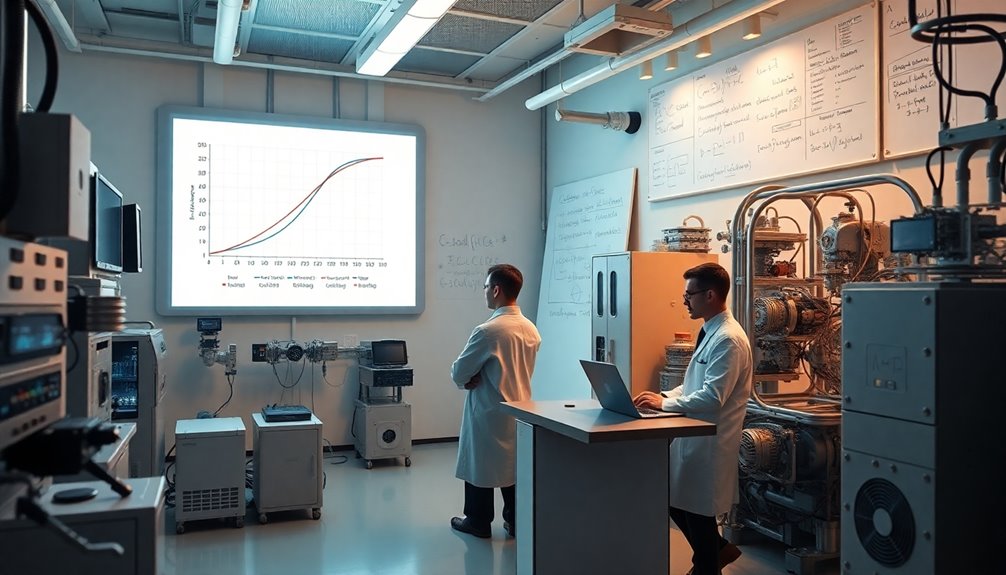When you assess multi-objective optimization in electrical machines using surrogate models, you unlock great potential while navigating some hurdles. These models can drastically cut down computational costs, but choosing the right one is crucial due to the complexities involved. Balancing conflicting objectives like efficiency and cost is challenging, and you have to ensure robustness against real-world variations. Discovering the right strategies can enhance your design process and lead to better performance outcomes. There's much more to explore in this area.
Key Takeaways
- Multi-objective optimization balances efficiency, cost, and performance, crucial for designing electrical machines with competing goals.
- Surrogate models act as efficient proxies, significantly reducing computational costs while maintaining accuracy in optimization processes.
- Challenges include conflicting objectives, high computational demands, and the risk of premature convergence to suboptimal solutions.
- Techniques like evolutionary algorithms and customized repair operators enhance optimization efficiency and ensure solution feasibility in complex problems.
- Understanding Pareto-optimal solutions aids informed decision-making, balancing manufacturing costs, speed, and noise levels for improved design outcomes.

Multi-objective optimization (MOO) plays a crucial role in designing electrical machines, helping you balance competing goals like efficiency, cost, and performance. In this complex landscape, MOO utilizes advanced techniques like genetic algorithms and evolutionary algorithms to sift through multiple interacting variables. Your objective is to identify Pareto-optimal solutions that represent the best compromises among these conflicting design objectives.
One innovative approach to enhancing MOO is the use of surrogate models. These models serve as efficient proxies, approximating complex systems and significantly reducing computational costs without requiring extensive simulations. By applying surrogate models, you can optimize designs for machines, such as the five-phase permanent magnet synchronous machine, while maintaining accuracy and efficiency. However, selecting the right surrogate model can be tricky, given the diverse complexities of different problems. Surrogate-assisted modeling has been shown to significantly ease design challenges in electrical machine optimization.
Challenges persist in the realm of multi-objective optimization. You often face conflicting objectives, such as improving efficiency while keeping costs low. High-fidelity models might demand extensive computational resources, leading to longer optimization runtimes. There's also the risk of premature convergence, where algorithms may settle on suboptimal solutions too quickly, compromising the quality of your results.
To tackle these challenges, ensuring robustness in your designs is essential, particularly to accommodate parameter variations in real-world applications. Conducting tolerance analysis becomes vital to confirm that your optimized designs can withstand varying conditions.
Furthermore, evolutionary multi-objective algorithms, like the Non-dominated Sorting Genetic Algorithm II (NSGA-II), have gained traction for efficiently handling complex problems. You can employ customized repair operators to maintain solution feasibility while minimizing computational costs.
Ultimately, understanding the physical implications of your Pareto-optimal solutions will empower you to make informed decisions based on criteria like manufacturing cost, achievable speed, and noise. By navigating these opportunities and challenges, you can enhance the design quality of electrical machines through effective multi-objective optimization.
Frequently Asked Questions
What Are the Main Types of Surrogate Models Used in Optimization?
When you're exploring optimization, you'll encounter several main types of surrogate models.
Radial Basis Functions (RBFs) offer flexible approximations, while Gaussian Processes (GPs) provide high accuracy.
Multivariate Adaptive Regression Splines (MARS) are also popular for their adaptive nature.
Each model has its strengths; RBFs excel in nonlinear cases, GPs shine in complex scenarios, and MARS balances accuracy with interpretability.
Choosing the right one depends on your specific needs and constraints.
How Can Surrogate Models Improve Computational Efficiency in Optimization Processes?
Surrogate models can significantly improve computational efficiency in optimization processes by approximating complex fitness functions. They reduce the need for expensive function evaluations, allowing you to explore design spaces faster.
With simplified representations, you'll experience quicker convergence in your algorithms. Additionally, these models enable you to conduct extensive analyses without the usual computational burden, making it easier to identify optimal solutions while maintaining accuracy in your results.
What Industries Benefit Most From Multi-Objective Optimization in Electrical Machines?
You'll find that several industries benefit significantly from multi-objective optimization in electrical machines.
E-mobility relies on efficient motors with minimal environmental impact. In railway applications, optimizing performance ensures reliability and efficiency.
The marine segment demands motors that adapt to varying conditions, while aerospace focuses on high power-to-weight ratios.
Additionally, optimizing for sustainability targets across these sectors enhances material usage and compliance with regulations, making your solutions more effective and eco-friendly.
Are There Specific Software Tools Recommended for Implementing Surrogate Models?
In today's tech-savvy world, choosing the right software tools for implementing surrogate models is crucial.
You might want to explore SMT, an open-source Python package that supports various methods like kriging.
Alternatively, COMSOL Multiphysics offers advanced features, including deep learning models.
Each tool has its strengths, so think about your specific optimization needs and data characteristics to select the best fit for your project's success.
How Do Surrogate Models Handle Uncertainties in Electrical Machine Designs?
Surrogate models handle uncertainties in electrical machine designs by leveraging historical data to make accurate predictions.
They improve over time as you feed them more data, helping you create robust designs less affected by uncertainties.
By integrating techniques like Monte Carlo simulations and multi-fidelity models, you can balance accuracy and computational efficiency.
This allows you to explore the design space effectively and make informed decisions despite the inherent uncertainties in your designs.
Conclusion
In the whirlwind world of electrical machines, multi-objective optimization isn't just a fancy term; it's the holy grail! By harnessing surrogate models, you're not just streamlining design processes—you're unleashing a torrent of possibilities that could revolutionize the industry! But beware, as with all powerful tools, pitfalls lurk around every corner. Embrace the journey, tackle the challenges head-on, and you could unlock a future where efficiency and innovation collide in a spectacular explosion of brilliance!








